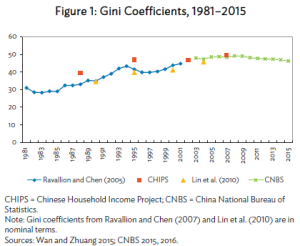 Has income inequality increased or decreased in China in recent years? The chart provides the clear answer. It’s decreased.
Has income inequality increased or decreased in China in recent years? The chart provides the clear answer. It’s decreased.
This is consistent with an intuitive theory [Kuznet’s Curve] that posits developing economies will experience increasing income inequality in the early stages of their development; but this will reverse in the later stages.
So we’re all good then? No problem with income inequality in China; case closed, move on?
Not so fast.
In the paper highlighted this week from Juzhong Zhuang, deputy chief economist and deputy director general at the Economic Research and Regional Cooperation Department of the Asian Development Bank and Li Shi professor at Beijing Normal University the researchers note recent trends but worry they may be temporary.
Take a step back and consider how from the 1980’s, when the Gini-coeffecient in China was 30, it increased to it’s peak of 46 in 2008?
Four factors were driving increasing inequality:
Skills; people who could do more got paid more. As there was more to do more people learned how to do it better and a virtuous circle ensued.
Spatial inequality; lived on the coast? You were a winner. Lived in a big town? Ditto. Stuck planting radishes; not so good.
Capital income rose faster than labor income. We’re talking mostly about property. Gifted a worker’s living unit in a large town? Xie-xie. Inherited a farm in Anhui? Meh.
Distribution of human capital. Or,how the well-off become more so. With extra money comes the ability to upgrade skills and those of your kids.
The problem with these gains is most can be attributed not to the invisible-hand of unbridled market forces but to the more visible hand of state planning and policy. If this situation should change, the researchers worry, the gains since 2008 may backslide.
They conclude by observing in more fully developed models taxation and transfers play a bigger role in income distribution than in present day China; and by implication suggest that’s where China will have to go if the gains made in recent years are to be built on.
Even a one-Party state with the power and prestige the Communist Party of China enjoys (at home at least) is unlikely to advertise a shift of policy to higher taxes; but, inevitably it seems, such a shift will be required.
You can read the paper in full by clicking this link Understanding Income Inequality Trends in China
Happy Sunday